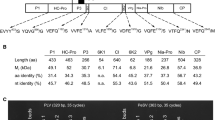Abstract
The complete genome sequence of a new virus isolated from a longan (Dimocarpus longan Lour.) plant showing witches’ broom syndrome was determined. The viral genome is composed of a monopartite single-stranded RNA of 9,428 nucleotides excluding the 3’ poly(A) tail and contains one large single open reading frame encoding a polyprotein of 3086 amino acids. BLAST searches of protein databases showed that the encoded polyprotein has a maximum amino acid sequence identity of 35% (with 85% coverage) to that of the isolate Minnesota of rose yellow mosaic virus (RoYMV; family Potyviridae; genus not assigned). Molecular and phylogenetic analysis of the genome and encoded protein sequences showed that the identified virus has the general features that are characteristic of members of the family Potyviridae although it has extremely low sequence similarity to known members of the family Potyviridae. The name longan witches’ broom-associated virus (LWBaV) is proposed for this new virus, which may be considered a member of a new genus in the family Potyviridae.

Similar content being viewed by others
Change history
07 July 2017
An erratum to this article has been published.
References
Adams MJ, Antoniw JF, Fauquet CM (2005) Molecular criteria for genus and species discrimination within the family Potyviridae. Arch Virol 150:459–479
Chen JY, Chen JY, Xu XD (2001) Advances in research of longan witches’ broom disease. Acta Hortic 558:413–416
Yx D (1990) Partial purification of a filamentous virus from longan (Dimocarpus longana Lam.) witches’ broom diseased trees. Chinese J Virol 6:284–286
He DP, Zeng ML, Zhou BP, Lin SX, Peng JX, Li JY, Huang WM (2001) Occurrence, cause and control of longan witches’ broom in Guangdong. Acta Hortic 558:407–412
Hoat TX, Quan MV, Hao LV, Chi TT, Anh DTL, Son PV, Cuong NN, Bertaccinic A (2017) Association of Eriophyes dimocarpi (Acari: Eriophyidae) with longan witches’ broom disease in Vietnam. Arch Phytopathol Plant Prot 50:70–83
International Committee of Taxonomy of Viruses (2015) Virus taxonomy: 2015 release. http://www.ictvonline.org/virusTaxonomy.asp. Accessed 11 April 2016
Kondo T, Fujita T (2012) Complete nucleotide sequence and construction of an infectious clone of Chinese yam necrotic mosaic virus suggest that macluraviruses have the smallest genome among members of the family Potyviridae. Arch Virol 157:2299–2307
Kumar S, Stecher G, Tamura K (2016) MEGA7: molecular evolutionary genetics analysis version 7.0 for bigger datasets. Mol Biol Evol 33:1870–1874
Mollov D, Lockhart B, Zlesak D (2013) Complete nucleotide sequence of rose yellow mosaic virus, a novel member of the family Potyviridae. Arch Virol 158:1917–1923
Nguyen TTD, Paltrinieri S, Mejia JF, Hoat TX, Bertaccini A (2012) Detection and identification of phytoplasmas associated with longan witches’ broom in Vietnam. Phytopathogenic Mollicutes 2:23–27
Schelhorn SE, Fischer M, Tolosi L, Altmuller J, Nurnberg P, Pfister H, Lengauer T, Berthold F (2013) Sensitive detection of viral transcripts in human tumor transcriptomes. PLoS Comput Biol 9:e1003228
Seo JK, Ohshima K, Lee HG, Son M, Choi HS, Lee SH, Sohn SH, Kim KH (2009) Molecular variability and genetic structure of the population of soybean mosaic virus based on the analysis of complete genome sequences. Virology 393:91–103
Seo JK, Kang M, Kwak HR, Kim MK, Kim CS, Lee SH, Kim JS, Choi HS (2015) Complete genome sequence of motherwort yellow mottle virus, a novel putative member of the genus Torradovirus. Arch Virol 160:587–590
Seo JK, Kwak HR, Lee YJ, Kim J, Kim MK, Kim CS, Choi HS (2015) Complete genome sequence of bellflower vein chlorosis virus, a novel putative member of the genus Waikavirus. Arch Virol 160:3139–3142
Susaimuthu J, Tzanetakis IE, Gergerich RC, Martin RR (2008) A member of a new genus in the Potyviridae infects Rubus. Virus Res 131:145–151
Acknowledgements
This research was supported in part by grants from the Agenda Program (PJ011306) funded by the Rural Development Administration of Korea and the Intramural Support Program (1403-20160062) funded by Seoul National University.
Author information
Authors and Affiliations
Corresponding authors
Ethics declarations
Conflict of interest
The authors declare that they have no conflict of interest.
Ethical approval
This article does not contain any studies with human participants or animals performed by any of the authors.
Additional information
An erratum to this article is available at https://doi.org/10.1007/s00705-017-3458-2.
Rights and permissions
About this article
Cite this article
Seo, JK., Kim, MK., Kwak, HR. et al. Complete genome sequence of longan witches’ broom-associated virus, a novel member of the family Potyviridae . Arch Virol 162, 2885–2889 (2017). https://doi.org/10.1007/s00705-017-3405-2
Received:
Accepted:
Published:
Issue Date:
DOI: https://doi.org/10.1007/s00705-017-3405-2




